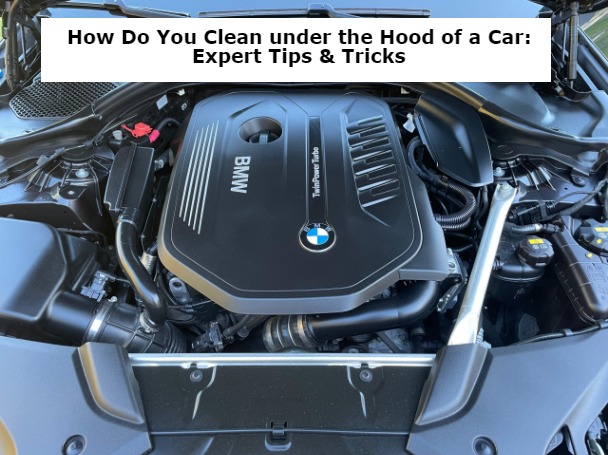How Do You Clean under the Hood of a Car: Expert Tips & Tricks
Keeping the engine bay clean enhances the car’s performance and longevity. Dirt, grease, and debris can accumulate under the hood over time. This buildup can impact the engine’s efficiency and cooling. Regular cleaning prevents potential damage and ensures optimal operation.
A clean engine bay also makes spotting leaks and worn-out parts easier. Using the right tools and cleaning agents is crucial. Always prioritize safety by disconnecting the battery and avoiding water contact with sensitive components. A clean engine bay looks good and improves the car’s overall health.
Preparation Steps
Always turn off the engine before cleaning. Let the engine cool down first. Wear gloves and safety glasses to protect yourself. Keep a fire extinguisher nearby, just in case. Avoid smoking or using open flames near the car. Ensure the car is in a well-ventilated area.
Gathering the right supplies is important. You will need cleaning clothes, brushes, and a bucket. Use a mild detergent or a special engine cleaner. Have a hose or a spray bottle filled with water. Keep a vacuum handy for debris removal. Lastly, get some protective covers for sensitive parts.
Initial Inspection
Always start by checking for leaks under the hood. Leaks can be from oil, coolant, or other fluids. Look for wet spots or drips on the engine and nearby parts. Fixing leaks early can prevent bigger problems later. Use a flashlight to see better in dark areas. Cleaning up any spills or leaks is also important.
Before cleaning, identify all electrical components under the hood, including the battery, alternator, and fuses. Cover these parts with plastic bags to protect them from water, which can damage electrical parts and cause malfunctions. Make sure to secure the plastic bags tightly.
Engine Cooling
Always wait for the engine to cool before cleaning. Hot engines can cause burns. Touch the hood to check the temperature. If it feels hot, wait longer. A cool engine is safe to clean and work on.
Start by removing the battery for safety. Locate the battery under the hood. Disconnect the negative cable first. Next, disconnect the positive cable. Carefully lift the battery out. This prevents electric shocks.
Covering Sensitive Areas
Cleaning under a car’s hood involves removing dirt and grime from the engine bay. Use a degreaser and soft brush for gentle scrubbing. Ensure all electrical components are covered before rinsing with water.
Protecting Electrical Parts
Cover all electrical parts with plastic bags, including batteries, alternators, and fuses. Use tape to secure the bags. Make sure no water can seep in, which prevents short circuits.
Sealing Air Intakes
Block the air intake with plastic wrap. Engines need protection from water, which can cause serious damage in the intake. Use rubber bands to keep the wrap tight, making sure the wrap covers the entire intake.
Degreasing The Engine
Choose a degreaser that is safe for your engine. Make sure it is non-corrosive. Water-based degreasers are usually a good choice. They are less harsh on engine parts. Check the label for compatibility with your car’s materials. Avoid products with strong chemicals.
Start with a cool engine. Cover sensitive parts with plastic bags. Spray the degreaser evenly over the engine. Allow it to sit for a few minutes. Use a brush to scrub tough spots. Rinse with a low-pressure hose. Dry with clean towels.

Cleaning And Scrubbing
Use a soft brush to reach tight spots. Microfiber cloths are great for wiping larger areas. Avoid harsh brushes that can scratch. Dip the brush in soapy water for better cleaning. Wipe with a damp cloth to remove soap.
Gently rinse with a low-pressure hose, being careful not to wet electrical parts. Use a spray bottle for precise rinsing. Pat dry with a clean towel. Let the engine air dry fully before starting.
Drying The Engine
Compressed air is effective for drying the engine. It blows away water quickly. Aim the air nozzle at wet spots. Keep the nozzle at a safe distance. This prevents damage to parts. Move the nozzle back and forth. Cover all areas thoroughly. A leaf blower can also be used. It provides a similar effect. Drying takes less time with these tools. Ensure all parts are dry before starting the engine. This avoids electrical problems.
Reassembling Components
Reconnecting the Battery is an important step. First, make sure the battery is clean and dry. Attach the positive cable to the positive terminal. Use a wrench to tighten the terminal. Next, connect the negative cable to the negative terminal. Tighten it securely with a wrench. Always ensure the cables are tight and secure.
After reassembling, a Final Inspection is necessary. Check all components for proper installation. Ensure no tools or loose parts are left behind. Verify all connections are tight. Start the engine to make sure everything works well. Listen for any unusual sounds. Fix any issues you find before driving.
Frequently Asked Questions
How Often Should You Clean Under The Hood?
Cleaning under the hood every six months is ideal.
What Tools Are Needed For Cleaning?
You need a brush, degreaser, and microfiber cloth.
Can You Use Water To Clean Under The Hood?
Yes, but cover electrical components to prevent damage.
Is It Safe To Clean The Engine Bay Yourself?
Yes, with proper precautions and tools, it’s safe.
What Areas Should You Avoid When Cleaning?
Avoid electrical components, battery, and air intake.
How Do You Dry The Engine Bay?
Use a microfiber cloth or let it air dry.
What Is The Best Cleaner For Engine Bay?
A quality degreaser is best for cleaning engine bays.
Conclusion
Cleaning under the hood of your car ensures optimal performance. Regular maintenance prevents costly repairs and extends engine life. Follow the steps for a thorough cleaning. Keep your car running smoothly and efficiently. A clean engine bay also adds to the vehicle’s resale value.
Happy cleaning!







